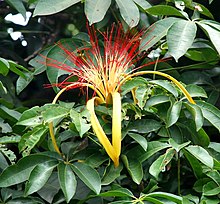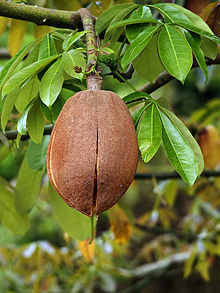Pachira aquatica
| Pachira aquatica | ||||||||||||
|---|---|---|---|---|---|---|---|---|---|---|---|---|

Pachira aquatica |
||||||||||||
| Systematics | ||||||||||||
|
||||||||||||
| Scientific name | ||||||||||||
| Pachira aquatica | ||||||||||||
| Aubl. |
Pachira aquatica ( Syn .: Bombax macrocarpum (Schltdl. & Cham.) K. Schum., Carolinea macrocarpa Cham. & Schltdl., Pachira macrocarpa (Cham. & Schltdl.) Walp.), German also wild cocoa tree , Guyana or Malabar Chestnut or lucky chestnut and water chestnut in Central Europe usually simply called pachira. The home of the species is in Central America from Mexico to northern Brazil. In frost-prone areas, the ornamental Pachira can only be cultivated as a pot plant indoors or in a greenhouse.
Plant description
The evergreen deciduous tree reaches heights of 4 to 20 meters outdoors. It forms a slightly thickened trunk base with smaller roots or buttress roots , which also serves as a water reservoir. The relatively smooth bark is brown to gray and slightly cracked, young twigs are bright green. At home, Pachira aquatica develops a broad crown.
The alternate and long-stalked, composed hand-shaped, slightly leathery leaves are arranged at the branch ends. The petiole is up to 24 cm long. The leaves are bright green and shiny and consist of up to nine entire leaflets (fingers). The mostly bald, short-stalked leaflets are up to 20–28 cm long and rounded to round-pointed, pointed or pointed. They are lanceolate to eilanceolate or obovate, with a light central vein. There are falling stipules.
The greenish-yellow or cream-colored, hermaphrodite and very large, short and thick-stalked flowers with double petals look like shaving brushes, due to the many long stamens that are red at the tip . The structure of the terminally and individually or in twos or threes appearing flowers suggests that bats are the pollinators. The up to about 2 cm long, externally fine-haired, green-brown and overgrown calyx is blunt and cup-shaped, the 5 narrow and elongated petals are up to 18-30 cm long and set back in the upper half. The approximately 180–250 stamens with white-reddish stamens and elongated anthers are closely fused in the lower third and tufted on top. The five-chamber ovary is on top with a long stylus with a split, short lobed stigma .
The large, brown, woody and up to 20-30 cm long, rough, egg-shaped capsule fruits have a diameter of about 10-15 cm and contain 10-25 seeds. The fruits weigh up to about 1–1.5 kg. The round seeds are about 2-3 cm in size and brownish, they lie in a spongy and fibrous pericarp . They are toxic to rats in their raw state, but humans can consume them raw or roasted or cooked. Plants offered as indoor plants are often Pachira glabra .
ground
The pachira thrives in common potting soil as well as in hydroponics. A variant from Hawaii is the cultivation in a lava stone as a bonsai . In this case, the plant grows extremely slowly. To do this, a thumb-sized hole is drilled into a porous lava stone and the pachira is placed in it. The roots make their way through the lava rock and finally blow it up.
maintenance
The pachira likes a lot of light, but also tolerates partial shade at times, at room temperatures between 12 ° C and 25 ° C.
The plant prefers drying out between waterings. The best durability can be achieved if it is kept rather dry. Particularly in the winter months , care should be taken not to water excessively. Dry heating air is to be avoided, it is best to spray it daily, otherwise it can react by throwing leaves. In the first year the plant should not be fertilized. After that, a little fertilizer can be added every 2–3 weeks during watering in summer .
If the growing conditions are good, the plant will grow quite quickly. If it gets too big, it can simply be cut back to the desired size. After about 1–2 weeks, new shoots form on the side of the cut-off areas.
use
The seeds are eaten raw or cooked, roasted or fried. They can also be ground into flour and baked.
Young flowers and leaves are used as vegetables.
literature
- Halina Heitz: The large GU houseplants book. Verlag Gräfe u. Unzer Munich, 2003, ISBN 3-7742-5630-6 .
- Food and fruit-bearing forest species. 3: Examples from Latin America , FAO Forestry Paper 44/3, FAO 1986, ISBN 92-5-102372-7 , p. 213 ff.
- Annals of the Missouri Botanical Garden. 51, 1964, pp. 45-47, online at biodiversitylibrary.org.
Web links
- Pachira aquatica at Useful Tropical Plants.
Individual evidence
- ↑ JTA Oliveira, IM Vasconcelos, LCNM Bezerra, SB Silveira, AC O Monteiro, RA Moreira: Composition and nutritional properties of seeds from Pachira aquatica Aubl, Sterculia striata St Hil et Naud and Terminalia catappa Linn. In: Food Chemistry. Vol. 70, No. 2, 2000, pp. 185-191, DOI: 10.1016 / S0308-8146 (00) 00076-5 .
- ^ Jules Janick, Robert E. Paull: The Encyclopedia of Fruit and Nuts. CABI, 2008, ISBN 978-0-85199-638-7 , p. 182 ff.
- ↑ Pachira aquatica on fukubonsai.com.

